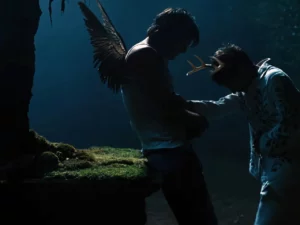Filmmakers use symbolism as a subtle language to convey deeper meaning and emotion to audiences beyond what is immediately apparent in the story. The fundamental principle behind symbolism is to express thoughts beyond the literal understanding of a character or situation via the use of metaphors, motifs and symbols. Bakony claims that, ““Symbols are subtle, delicate, sometimes complex, sometimes ephemeral, in a way limitless and frequently elusive.” In film, symbols serve as guides, leading viewers through a maze of feelings, ideas and concepts. Stories are made richer by symbols, which can be anything from a recurrent visual pattern to a cultural reference or a subtle narrative thread. Filmmakers are able to convey deep, universal themes through symbols because they serve as a conduit between the conscious and subconscious minds.
Cinematic symbolism has its origins in the silent era when directors tried out visual metaphors to communicate ideas and emotions without speaking. Fritz Lang and F.W. Murnau, two pioneering filmmakers, paved the way for the symbolic language that would develop throughout the years. Visionary directors such as Ingmar Bergman and Alfred Hitchcock used symbolism as a strong narrative device as cinema evolved.
The beauty of symbols is they can be shown through anything we see, hear or feel in a film. From a simple object, to a song, every aspect on screen can be taken into account when identifying symbols. For example, in the movie Saltburn, an object is constantly seen throughout, which is the statue of a minotaur. The minotaur represents a story from Greek mythology, in which a hero named Theseus kills the minotaur however tricks the royal family and keeps the crown for himself. It is a reflection of the actual story of the movie in which the main character can portray Theseus.

Another thing many people don’t consider when they think of symbols is the colors or the hues we see on screen. Color theory is very important to art since it demonstrates can interact with one another but also, how people can react to certain colors.1 The ability to change someone’s mood or feelings with a simple color is very powerful. The Matrix is a movie franchise that uses color theory really well in explaining what is going on in the film. In the film, the characters jump back and forth from reality and color is used to demonstrate that. When in the simulation, we see green, yellowish hues, likely to depict the sickness and corruption of a prison, which the characters are in.
The symbolic components in a film may be elevated by the intentional use of framing. Cinematic framing communicates ideas, personality quirks, and story motifs via visual composition, working as a symbolic language. A broad image of a character against expansive landscapes could represent their loneliness or quest for purpose, yet a close-up of their face could indicate closeness or emotional fragility. The 2023 movie of The Society of the Snow does a great work using frames to convey what the characters are feeling in that moment. When they show a wide shot of a landscape they are trying to show how hopeless and small the characters felt in that moment. Usually, when directors use a closeup in a scene they are trying to show the larger theme of the film like struggle and loss, through the face of the character and framing of the shot. According to Raleigh, “The close-up has objectified in our world of perception our mental act of attention and by it has furnished art with a means which far transcends the power of any theater stage.”Cinematic experiences are enhanced with hidden symbolism when directors purposefully use framing to infuse scenes with deeper layers of meaning.

The arrangement of visual elements within the frame, or composition, is one of the key elements in the effectiveness of symbolism. Composition serves as a symbolic shortcut to communicate intricate ideasand character dynamics. For example, the protagonist’s journey through a doorway could symbolize their transition from one world or stage of life to another. Characters with different heights within the frame might also represent opposing views or power dynamics. According to Bakony: “Even the characters in a film sometimes become virtual symbols themselves.” These deliberate compositional choices enhance storytelling by amplifying audience engagement and offering several interpretations to each frame.
Utilizing light and shadow, cinematographers can add dimension, depth and drama to the scene and the entire film. Harsh or soft lighting can reveal a character’s true intentions or traits to the audience. Lighting was used extensively in The Godfather, for instance, to disclose more about the characters. For Marlon Brando’s role as the Godfather, director of photography Gordon Willis employed a special lighting method that prevented viewers from seeing his eyes—a view that was previously required in motion pictures. This method gave the character more nuance because it prevented the viewers from seeing his eyes, which would have allowed them to understand his thoughts.
Investigating the auditory aspect of symbolism in film uncovers a complex array of sounds and music that enhance the overall themes of cinematic stories. Sound design covers various elements such as dialogue, effects, and ambient noise. For example, the use of recurring sound motifs, such as ticking clocks, can convey the passage of time or create a sense of impending danger. This adds continuity and cohesion to the overall fabric of the film. Music has a significant impact on the creation of cinematic symbolism. Music selections are carefully chosen to enhance the overall experience of visual narratives, evoking various moods, emotions, and associations. Tomaselli agrees that, “Film music, for example, is designed to signify moods through a feed-forward linkage where alternatives are worked out in advance of the image.” The famous theme from “Jaws” conveys a sense of imminent danger with its distinctive two-note motif, while Hans Zimmer’s score for “Inception” reflects the dreamlike storyline, blurring the boundaries between reality and illusion.

The use of symbolism in movies is a product of a collaborative effort by different creative individuals, who bring their expertise together to add depth and significance to the story. From screenwriters to cinematographers, directors to production designers, sound designers to composers, every member of the filmmaking team has a vital part in seamlessly incorporating symbolic elements into the story. Screenwriters create scripts that are rich in themes and motifs, allowing for meaningful visual representation. They incorporate symbols and metaphors into dialogue and plot points, offering a framework for the visual storytelling that ensues. Directors transform written symbols into the language of film, skillfully utilizing visuals, lighting, composition, and acting to strengthen thematic elements and improve the overall flow of the story. Their vision drives the entire production process, influencing the collective efforts of the cast and crew. Cinematographers work closely with directors to effectively convey symbolism through visual storytelling. Camera techniques, framing, and lighting are employed to emphasize symbolic elements in each frame, amplifying their impact and significance. Production designers and art directors play a crucial role in creating visually impactful sets, props, and costumes that convey symbolic meaning. They use a range of visuals that enhance the themes and make the storytelling more engaging. Actors bring symbolism to life through their performances, embodying characters whose actions and interactions convey deeper meaning in a clear and accessible manner. They add depth and subtlety to their characters through small gestures, expressions, and choices. Editors play a crucial role in crafting the narrative, strategically arranging images and sequences to enhance the power of symbolic moments. Their selection of pacing and rhythm has the ability to heighten the symbolic impact of a scene, captivating viewers and immersing them in the narrative. Sound designers and composers utilize auditory elements to enhance the visual symbolism found in the film. By utilizing various sound effects, recurring musical themes, and subtle atmospheric cues, these elements work together to elicit emotions and enhance the overall thematic elements, thereby enriching the cinematic experience.
Symbols are essential in shaping the storyline and characters of a film, adding depth and significance to the narrative. Symbols serve as a leading string that guides viewers through the narrative, encouraging them to interpret and engage with the story on various levels. Symbols in films provide audiences with a deeper comprehension of the underlying ideas and messages, whether they appear as visual motifs, recurring objects, or metaphorical representations. 2

In addition, symbols play a significant role in shaping the development of characters, as they unveil their inner motivations, conflicts, and transformations. The use of symbols and objects can shed light on a character’s journey and development, giving valuable insights into their motivations. Symbols have the ability to enrich the overall atmosphere and mood of a film, adding depth and unity to the scenes. By utilizing various elements such as color symbolism, visual motifs, and auditory cues, symbols play a crucial role in creating a unified aesthetic that strengthens thematic motifs and improves the overall coherence of storytelling. Instead of existing in isolation, cinema flourishes through the interactions between these elements, seamlessly integrating them across traditional boundaries. The beauty lies in how it effortlessly blends various artistic disciplines, forming fresh connections and crafting one-of-a-kind cinematic experiences3Ultimately, symbols play a crucial role in the art of filmmaking, enhancing narratives with depth, resonance, and complexity. By working together and using artistic techniques, filmmakers are able to utilize symbolism to captivate viewers, elicit feelings, and stimulate meaningful conversations.
Bakony, E. (1974, July 31). Symbolism in the feature film. ERIC. https://eric.ed.gov/?id=ed096715
Tomaselli, K. (n.d.). (PDF) semiotics, Semiology and film. Research Gate. https://www.researchgate.net/publication/365653744_Semiotics_semiology_and_film
- Bakony, Ed. “Non-Verbal Symbolism in the Feature Film.” Journal of the University Film Association 26, no. 3 (1974): 34–38. http://www.jstor.org/stable/20687249. ↵
- Bakony, E. (1974, July 31). Symbolism in the feature film. ERIC. https://eric.ed.gov/?id=ed096715 ↵
- Raleigh, Henry P. “Film: The Revival of Aesthetic Symbolism.” The Journal of Aesthetics and Art Criticism 32, no. 2 (1973): 219–27. https://doi.org/10.2307/429039. ↵




4 comments
Natalia De la garza
Thank you for your work—I loved it! You’ve done such an amazing job exploring and explaining the use of symbolism in film. It’s clear how much thought and effort you put into crafting this, and it was a joy to read. Great work!
Gaitan Martinez
Great article, it’s funny to me because now whenever I watch movies, I can’t help but attempt to look at every little detail to find some form of symbolism. Many of the times it is very obvious, but sometimes the director implements their easter eggs discreetly. If there is a certain small detail that keeps getting a camera shot, it makes me think and research the meaning, just like the author’s example, Saltburn.
Rhys Williams
I thoroughly enjoyed delving into the auditory dimensions of symbolism in film. Your discussion adeptly highlights how sound design and music selection contribute to the rich tapestry of cinematic storytelling. The quote by Tomaselli, “Film music, for example, is designed to signify moods through a feed-forward linkage where alternatives are worked out in advance of the image,” resonates deeply, emphasizing the intricate interplay between music and visual narratives. Examples like the iconic “Jaws” theme and Hans Zimmer’s score for “Inception” vividly demonstrate how music can evoke emotions and enhance the viewer’s immersion in the film’s world.
Stela Naomi Sifuentes
The use of signs and symbols in movies adds a whole new dimension to the storytelling. It’s like unraveling a mystery with each hidden meaning, making the viewing experience richer and more rewarding. I love how filmmakers use signs and symbols to convey deeper meanings and themes in movies. Great article Mariana!